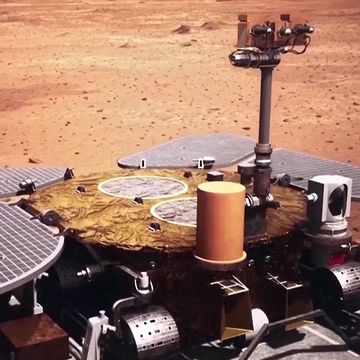The Mars Helicopter is the latest in a line of ambitious, low-cost craft meant to revolutionize planetary exploration by taking to the air. A team at NASA's Jet Propulsion Laboratory is working on a prototype set for completion by 2018, adding a new dimension to exploring other worlds by allowing a robotic probe to take to the skies as needed.
The autonomous, solar powered helicopter would work as a sort of scout for a rover, giving NASA teams a heads up to what they might encounter ahead and steering them toward the best possible location. Such ideas have been floating around NASA for the last 16 years, but the Mars Helicopter is ready to bring them to fruition. The team just has to have the robot helo ready in time for the Mars 2020 Rover—with the hopes that NASA lets it come aboard.
The Skies Over Mars
Curiosity, Spirit and Opportunity, the Phoenix Lander, even the Viking missions—NASA has gotten good as building robots that can crawl around the Martian surface. But we've never sent any kind of plane, glider, or helicopter to buzz around on the Red Planet.
That's partly because we still need to control out probes with direct input about where to go and how to get there. The more distant a robotic explorer is from Earth, the harder that becomes, thanks to the time lag involved in sending radio messages across vast distances. A radio signal to Mars can take anywhere from 4 to 24 minutes to arrive, and just as long for the reply to make it back.
But with advances in autonomous flight and unmanned aerial vehicles, it's becoming possible to imagine a flying Martian robot that travels on its own. The Mars Helicopter team at NASA's Jet Propulsion Laboratory thinks the flight tech is there.
"This thing has to be autonomous," says Mimi Aung, the guidance and control section manager at JPL. "We can't joystick it from Earth, and no one can joystick it from Mars for us."
Off-the-Shelf Explorer
The team's current plan is to build a helicopter with a 3.3-foot blade. "Taking about a one meter tip to tip wing length, we've been able to show we can lift one kilogram. That has to include everything," Aung says. One kilogram (2.2 pounds) might not sound like much, but with ordinary modern electronics, engineers can build a lot into a couple of pounds.
In fact, the researchers want to build Mars Helicopter with as many off-the-shelf parts as possible. That could include lightweight cameras (think something like a GoPro), CPUs with similar scale to what you'd find in robotic toys or smartphones, and consumer level batteries. The result is a bot you could (almost) build at home, though the team may have to build specialized parts for the helicopter rotor and body, and they don't know yet whether the motor will have to be custom built for the Mars copter.
Fly the Red Planet
The big idea behind the Mars Helicopter is that a rover mission would carry the small helo to Mars, where it could fly out ahead of the rover, scouting out areas for near-future exploration. Once it runs out of juice, the autonomous helo would make a slow descent back to the soil, absorbing solar energy via a top-mounted solar panel as it recharges over the next days activities.
"The immediate proposal we are putting forward is to use it as an imaging vehicle," Aung says. "Once the rover drops us off and drives away, this is a self-charging system."
The team has a timetable of three years to finish the craft; they hope to propose it as part of the Mars 2020 rover, Aung said. It's far from a given: The craft is just out of proof-of-concept stage and into prototyping now. But NASA's been at work on similar concepts for more than 15 years, so the demand is there.
"The idea of surveillance from the air seems inevitable," Aung says. "You can't just keep walking and driving and know where you're going." While robotics orbiters like the Mars Reconnaissance Orbiter now look down on Mars from space, they can't get the sort of resolution needed for such localized endeavors, Aung says.
The team even has a few ideas for the far-off future of the vehicle. "We're definitely not looking at this as a one-trick pony," Aung says. "It's all about adding the aerial dimension [to rovers]." Imagine a fleet of connected drone helos surveying an area in great numbers.
With that in mind, the scientists can see it scaling up on Mars for bigger missions. They could even carry a really precious payload someday: humans. While the current models are autonomous vehicles, they could be the proof-of-concept needed to launch a human-piloted helicopter on Mars. Aung also says the technology can be adapted to other worlds, including Titan and Venus, which have atmospheres that are much thicker than Mars' and offer a host of different challenges.
For now, they have to get their prototype ready. There's a ride they need to catch in 2020.
"We want to be on the next lander," Aung said, "and our preliminary timeline shows we can do it."
<














